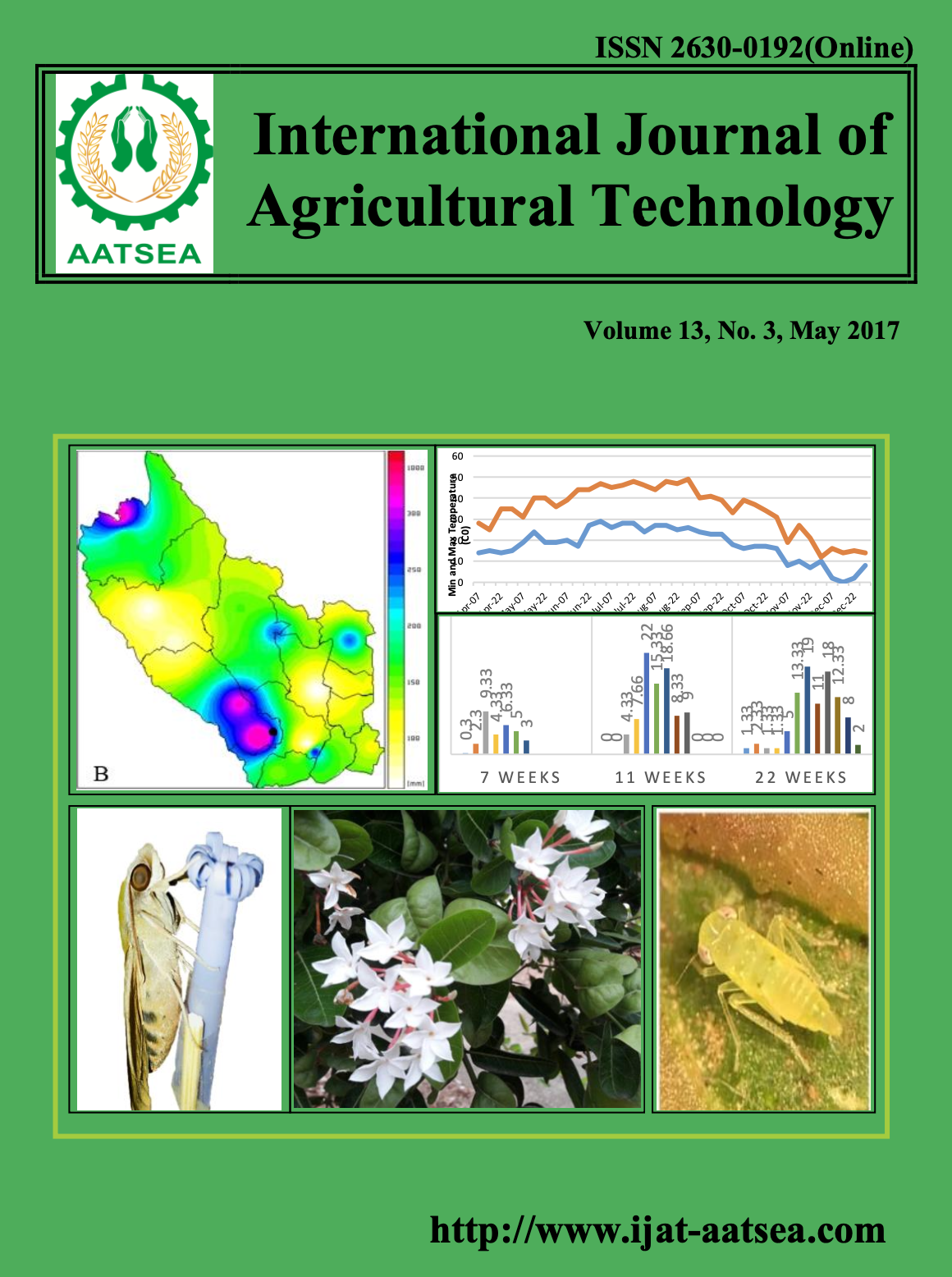Promotion of upland rice (Oryza sativa L.) growth by endophytic bacteria isolated from Nipa Palm (Nypa fruticans)
Main Article Content
Abstract
Nitrogen and phosphorus have been identified as poorly available in the nipa palm ecosystems. Although it represents low nutrient environment, nipa can still grow efficiently and able to sustain high productivity. Possible reason is that symbiotic microbes perform mechanisms that involve conversion of atmospheric nitrogen to ammonium and nitrates that are usable by plants. In this study, five endophytic bacteria: NBor1, Enterobacter aerogenes; NBor2, Raoultella planticola; NQb2, Pectobacterium cypripedii; NAyr1, Serratia marcescens; and NAol2, Pantoea agglomerans were evaluated for their potential in enhancing the growth of upland rice under screenhouse conditions at the Applied Biology Center for the Rice Environment, Philippine Rice Research Institute. These isolates were able to produce multiple plant growth-promoting compounds such as IAA, ACC-deaminase and phosphatase. Inoculation with isolates NBor1, NBor2, and NQb2 significantly increased shoot fresh weight ranging from 73% to 89% relative to the uninoculated control. Similarly, inoculation with NBor1 and NQb2 significantly increased root fresh weight by 238.34% and 204.36%, respectively. Highest shoot dry weight (8.91 g/pot) was obtained from NBor2 inoculated plants. Inoculation with NBor1 significantly increased root length by 30.21% relative to the uninoculated treatment. Moreover, inoculation with NBor2and NAol2 significantly increased root and shoot phosphorus uptake by 94.26% and 102.73%, respectively. The efficacy of the selected endophytic bacteria in enhancing the plant growth under screenhouse conditions suggests their potential as bio-fertilizing agent for upland rice. However, field assessment should be conducted to determine the effectiveness of endophytic nitrogen-fixing bacteria under the presence of biotic and abiotic stresses.
Article Details

This work is licensed under a Creative Commons Attribution-NonCommercial-NoDerivatives 4.0 International License.
References
Arshad, M., Saleem, M. and Hussain, S. (2007). Perspectives of bacterial ACC deaminase in phytoremediation. Trends in Biotechnology 25: 356-62.
Cruz, J. A. and Cadiente, M. K. M. (2016). Assessment of potential plant growth promoting compounds produced In Vitro by endophytic bacteria associated with Nipa Palm (Nypafruticans). Philippine Journal of Crop Science 41: 1-7.
Deivanai, S., Bindusara, A. S., Prabhakaran, G. and Bhore, S. J. (2014). Culturable bacterial endophytes isolated from mangrove tree (Rhizophora apiculata Blume) enhance seedling growth in rice. Journal of Natural Science 5: 437–444.
Glick B. R., Todorovic B., Czarny J., Cheng Z., Duan J. and McConkey B. (2007). Promotion of plant growth by bacterial ACC deaminase. Critical Reviews in Plant Sciences 26: 227-242.
Gyaneshwar, P., James, E. K., Mathan, N., Reddy, P. M., Reinhold-Hurek, B. and Ladha, J.K. (2001). Endophytic colonization of rice by a diazotrophic strain of Serratiamarcescens. Journal of Bacteriology 2634-2645.
Hossain, M. F. and Islam, M. A. (2015). Utilization of mangrove forest plant: Nipa Palm (Nypa fruticans Wurmb.). American Journal of Agriculture and Forestry 3:156-160.
Janarthine, S. R. O. and Eganathan, P. (2012). Plant growth promoting of endophytic Sporosar cinaaquimarina SjAM16103 isolated from the Pneumatophores of Avicennia marina L. International Journal of Microbiology Article ID 532060, 10 p.
Khan, M. S., Zaidi, A. and Wani, P. A. (2007). Role of phosphate-solubilizing microorganisms in sustainable agriculture - A review. Agronomy for Sustainable Development 27:29-43.
Li. J. H., Wang, E.T., Chen, W. F. and Chen, W. X. (2008). Genetic diversity and potential for promotion of plant growth detected in nodule endophytic bacteria of soybean grown in Heilongjiang province of China. Soil Biology and Biochemistry 40: 238–246.
Mantelin, S. and Touraine, B. (2004). Plant growth-promoting bacteria and nitrate availability: impacts on root development and nitrate uptake. Journal of Experimental Botany 55:27-34.
Mendes, R., Pizzirani-Kleiner, A. A., Araujo, W. L. and Raaijmakers, J. M. (2007). Diversity of cultivated endophytic bacteria from sugarcane: genetic and biochemical characterization of Burkholderia cepacia complex isolates. Applied Environmental Microbiology 73:7259-7267.
Nguyen, P. M. (2014). Factors influencing to nipa Nypa fruticans endosperm in canned food production. International Journal of Multidisciplinary Research and Development 1:126-131.
Rashedul, I. M., Madhaiyan, M., Deka, Boruah H. P., Yim, W., Lee, G. and Saravanan, V. S. (2009). Characterization of plant growth-promoting traits of free-living diazotrophic bacteria and their inoculation effects on growth and nitrogen uptake of crop plants. Microbiological Biotechnology 19:1213-1222.
Rodríguez, H. and Fraga, R. (1999). Phosphate solubilizing bacteria and their role in plant growth promotion. Biotechnology Advances 17:319-339.
Sharma, B. S., Sayyed, Z. R., Trivedi, H. M. and Gobi, A. T. (2013). Phosphate solubilizing microbes: sustainable approach for managing phosphorus deficiency in agricultural soils. Springer Plus 2:587.
Souza, R. D., Schoenfeld, R. and Passaglia, L. M. P. (2016). Bacterial inoculants for rice: effects on nutrient uptake and growth promotion. Archives of Agronomy and Soil Science 62:561-569.
Stephen J., Shabanamol S., Rishad K. S. and Jisha M. S. (2015). Growth enhancement of rice (Oryza sativa) by phosphate solubilizing Gluconacetobacter sp. (MTCC 8368) and Burkholderia sp. (MTCC 8369) under greenhouse conditions. Biotechnology 5:831-837.
Tang, S., Hara, S., Melling, L., Goh, K. and Hashidoko, Y. (2010). Burkholderia vietnamiensis isolated from rooendophytic nitrogen-fixing bacterium. Bioscience, Biotechnology and Biochemistry 74:1972-1975.


